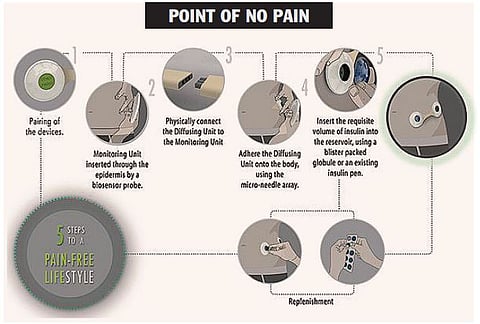

The case of the falling apple being the inspiration behind Sir Isaac Newton’s theory of gravity has by now become a part of scientific folklore. It appears that observations culled from personal experiences have led to many a scientific discovery. Similarly, it took a mosquito bite for Rajkot-based industrial designer Devina Kothari to come up with an almost painless way of administering insulin for diabetic patients. Being conferred with the Red Dot Award 2014 for her innovation, was the cherry on the success cake.
Diabetes runs in Kothari’s family. It was also the reason behind Kothari’s discovery which happened when one of her uncles who suffered from diabetes was not responding to medicines properly due to the insulin fluctuation in the body. This inspired the young designer to come up with a device that would be useful to diabetics like her uncle. Meanwhile, another of her concerns was that people with diabetes also had other health complications. So a lot of research went into making a device that would facilitate all sections of people. Also playing on her mind was the fact that people in rural areas considered diabetes a taboo.
Keeping all this in mind, she began the research on her new invention, which finally culminated in the Insulin Delivery System. So what is this device all about? “The entire system being closed looped. There are two major parts of the device—one is the monitoring unit, which has a bio-sensor that detects the fluctuation of insulin and blood glucose levels and transmits the data to the second part, that is the diffusing unit. Based on that, the required amount of insulin is passed on to the body,” she says.
That the device causes no pain was another notable benefit. Drawing the same parallel of a mosquito bite, she came up with the application of micro needle arrays. After several attempts, the final layout of the design was crafted out, which incidentally can also monitor the heart rate, an added health bonus. It is yet to be introduced in the market.
“This device is also helpful for people of all ages, from children to the elderly and for those who are differently abled,” says Kothari, adding that the device is quite fashionably designed to make it look like a health gear and not just any other conventional medical instrument.
Kothari’s works are not limited to this; she has also worked on a number of projects in other sectors along with health care. She has developed ‘cornea care’, an Opthalmic Enucleation Kit that preserves usability of corneas up to 96 hours. The ‘Mizu Ha’ is another device which was developed based on the IoT platform that automates valves (irrigation, illumination and energy distribution).
With more than a decade in the field of design, Kothari is now making utmost use of her set of skills as she continues to strive and make a significant impact on design and business units. Meanwhile, for those who wish to make optimum utilisation of their minds, Kothari has one final advice. “Never get daunted by failure because with each failed attempt you are going one step closer to success. So one must never keep stop oneself from innovating.”